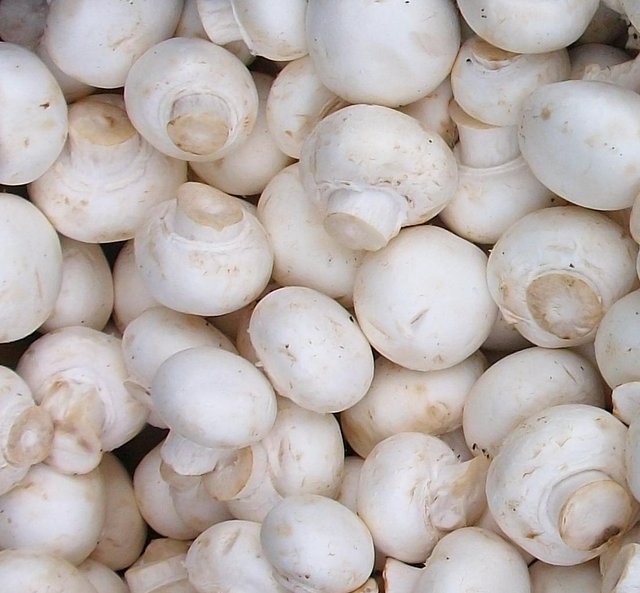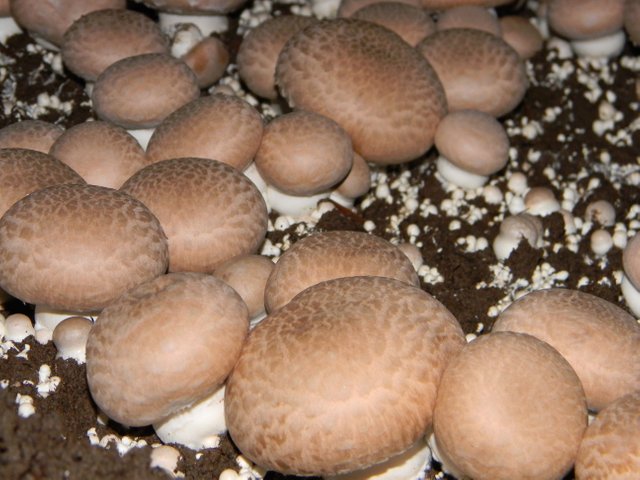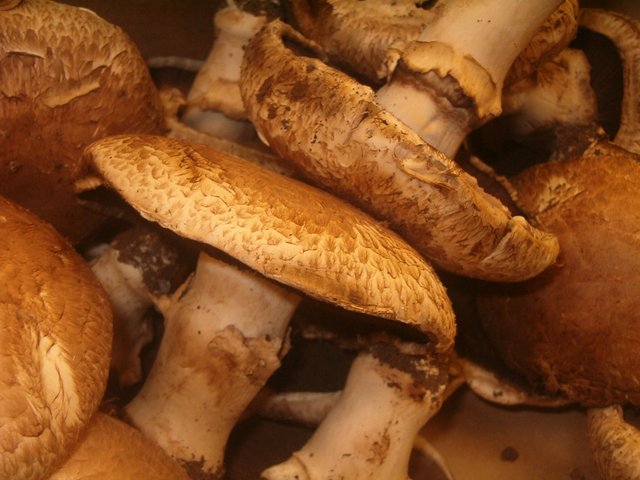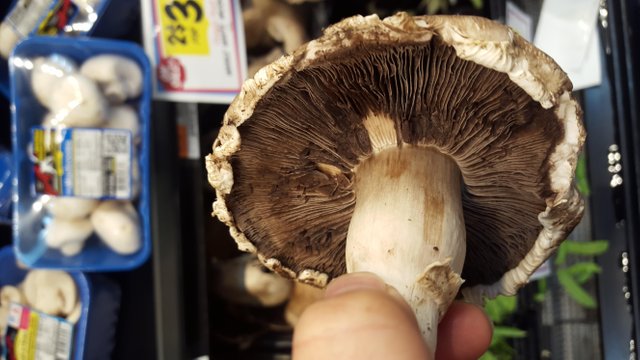The Amateur Mycologist #22 - Agaricus bisporus - AKA The White Button Mushroom, The Cremini Mushrom, And The Portobello Mushroom - Suesa Science Challenge Special
These posts are not for foraging. They are intended for entertainment and intellectual satisfaction only. These posts are not a field guide nor comprehensive in any way - their accuracy is not assured in any way. Do not eat wild mushrooms unless you are a professional, have substantial professional assistance or have a wealth of personal experience with a specific species. Do not make any foraging decisions based on these posts. To do so could be dangerous or life threatening.

The white button mushroom
Perhaps no other mushroom in the United States, and possibly around the world, is more familiar to normal people. Perhaps no other mushroom on Earth is grown or eaten in larger quantities. It was inevitable that I would cover this species, but i wanted to wait until just the right moment, and @suesa's science challenge about misconceptions couldn't be more perfect.
The white button mushroom you see in its packaging above is known scientifically as the species Agaricus bisporus. That little white mushroom is a very young A.bisporus, grown in countless dark, cave like mushroom farms around the United States.
But guess what other mushroom is ALSO A.bisporus...

The brown colored Cremini mushroom is the same species!
The white button mushroom and the similarly sized but darker colored Cremini mushroom are the same species - both A.bisporus. It is just a slightly different strain that turns brown instead of white, but the two are the same species.
But a Cremini mushroom is not the final mature form of A.bisporus...

That would be the giant Portobello mushroom!
That's right - all three of these mushrooms are the same exact species.
Most people don't know this, perhaps thinking their mushroom eating habits are significantly more diverse than they actually are. But when you go to the store and decide between a white button, a Cremini or a Portobello mushroom, no matter what you'll end up eating A.bisporus!
How did one mushroom singlehandedly take over the bulk of the U.S. market?
https://upload.wikimedia.org/wikipedia/commons/c/c3/IMG_0408_-Hungary-_Mushroom_Farm.JPG
There are several reasons for A.bisporus's commercial success
First, the species is safe. Well, mostly. Even the common white button mushroom can contain some volatile compounds when raw, including small amounts of Hydrazine, which is a known carcinogen. Cooking eliminates these heat sensitive chemicals, which is why you should always cook your white button mushrooms.
Second, they're easy to grow in large scales. Tom Volk writes in great detail about the industrial process of growing A.bisporus. However, in summation, A.bisporus reproduces prolificly and with great consistency, and it can be grown on the properly sterilized waste of other food industries.
Third, they are resilient. They pack well, in all three of its predominant forms, and last a surprising long time in shipping and then sitting in the supermarket and your fridge.
Fourth, they have a simple, non-threatening taste and texture. The white A.bisporus could fairly be called bland, which the Cremini and Portabello variants are slightly tastier at best. For the American mass market - where consistency and blandness tend to predominate - the bland taste is a major positive.
Fifth, and finally, the American consumer has become overwhelmingly comfortable with A.bisporus. So comfortable that when I say the word "mushroom", A.bisporus is the first thing to pop into the minds of most American consumers. That kind of wholesale recognition is a powerful, self fueling force.

For the beginner myco-enthusiast, A.bisporus presents an opportunity to learn
Whichever form you purchase them as, A.bisporus you buy in the store can be analyzed just like any other mushroom species.
As you well know, the species begins as a white button, often with a veil covering pink gills. Alternatively the Cremini variant has a brown, slightly textured cap and dark brown gills from inception.
The final form, the Portobello mushroom can range from 7 to 16cm in width. The gills are brown and close, with a sturdy stem, that often has a fairy ring around it, the remnants of the veil in the younger form.
You can go to the store, or your fridge, and take a spore print from one of these mushrooms. What you'll find is a dark brown print.
You can find A.bisporus in the wild, or many of its cousins in the Agaricus genus, but not all are edible.
But, lucky you, there are over $800 million dollars worth of A.bisporus sold every year in the United States - so if you get a hankering, stick to the supermarket!
Macroscopic Characteristics
Cap - Either white or brown with shaggy bits of texture on top. Both variants starting smallish, around 3cm, and expanding to upwards of 16cm, although I have seen monstrous Portobellos at Costco.
Flesh - white - stains brown when bruised
Stem - Stubby and white in most cases in the immature specimens, growing to be a bit bulbous on top, and upwards of 8cm in length. Mostly white in maturity, with some brown coloration. Sometimes a ring or anullus on the stem from the young veil remnants.
Gills - start a light pink color, maturing into a dark brown - free of the stem.
Distribution - May occur in organic material in the wild - but not totally clear what it's natural distribution is. However you will, of course, find it in every place that sells produce.
Ecology - Saprobic, grows on organic waste -usually in mass production farms
Other characteristics - make sure to cook them, raw mushroom can have trave amount of hydrazine. Since I never usually discuss eating mushrooms, let me take this rare opportunity to say they taste great sauteed in butter with onions or braised in a beef stroganoff.
[1]böhringer friedrich own work CC-SA-2.5, via wikicommons
[2]user I. G. Safonov IGSafonov at Mushroom Observer, a source for mycological images, CC-SA-3.0, via wikimedia commons
[3]Leif K.Brooks own work CC-SA-2.5, via wikimedia commons
[4]Andrew Bossi own work CC-SA-2.5, via wikicommons
[5][Mine]
[6]Jerzy Opiola own work, CC-SA-3.0 via wikimedia commons
Information Sources:
[1]Kuo On the A.bisporus
[2]Tom Volk on A.bisporus
[3]First-Nature on A.bisporus
[4]Wikipedia on A.bisporus
[5]Mushroom Appreciation on A.bisporus
Of all the reasons for A. bisporus to be our common commercial mushroom, reasons 2 and 3 are the most important, lol. There are so many other mushrooms that are more tasty!
I see wild morels, boletes, oysters, chanterelles, and other mushrooms in the stores here in Oregon. That helps folks not be so afraid of wild mushrooms, especially when they see that other people are willing to pay a lot for them -- like $40/pound for some old chanterelles.
And all the work by Paul Stamets and others, to make commercial production of other varieties practical, has really raised the acceptability and desirability of other kinds of mushrooms. Maybe A. bisporus will be the first kind of mushroom people eat, but I sure hope it's not the last! :D
There are definitely some great expansions happening in US mushroom tastes. But something tells me A.bisporus will remain a top contender for the foreseeable future. Especially since most people don't realize all the various forms of A.bisporus are the same mushroom, which gives a false sense of variety.
@dber got you a $7.38 @minnowbooster upgoat, nice! (Image: pixabay.com)
Want a boost? Click here to read more! @originalworks
The @OriginalWorks bot has determined this post by @dber to be original material and upvoted it!
To call @OriginalWorks, simply reply to any post with @originalworks or !originalworks in your message!
To enter this post into the daily RESTEEM contest, upvote this comment! The user with the most upvotes on their @OriginalWorks comment will win!
For more information, Click Here!
Special thanks to @reggaemuffin for being a supporter! Vote him as a witness to help make Steemit a better place!
It has great benefits in hair loss
I had not heard that
Your post is so great that I benefited from information about mushrooms that are useful and harmful at the same time
You have chosen the theme today and continued on this theme my friend
Congratulations @dber! You have completed some achievement on Steemit and have been rewarded with new badge(s) :
Click on any badge to view your own Board of Honor on SteemitBoard.
For more information about SteemitBoard, click here
If you no longer want to receive notifications, reply to this comment with the word
STOP